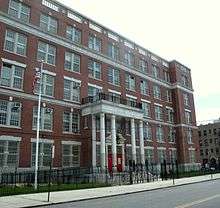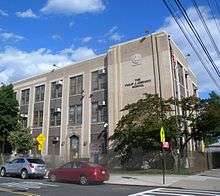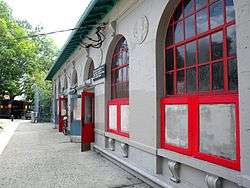Morris Park, Bronx
| Morris Park | |
|---|---|
| Neighborhood of The Bronx | |
|
Looking south along facade of Morris Park station | |
 Morris Park  Morris Park  Morris Park Location in New York City | |
| Coordinates: 40°51′08″N 73°51′12″W / 40.852322°N 73.853468°WCoordinates: 40°51′08″N 73°51′12″W / 40.852322°N 73.853468°W | |
| Country |
|
| State |
|
| City |
|
| Borough |
|
| Area[1] | |
| • Total | 0.90 km2 (0.347 sq mi) |
| Population (2011)[1] | |
| • Total | 10,289 (est.) |
| Economics | |
| • Median income | $52,658 |
| ZIP codes | 10461, 10462 |
| Area code | 718, 347, 646, 917 |

Morris Park is a working class neighborhood in the borough of the Bronx in New York City. The neighborhood is part of Community Board 11 in the East Bronx. Its approximate boundaries, starting from the north and moving clockwise, are Neill Avenue and Pelham Parkway to the north, Eastchester Road to the East, the Amtrak Northeast Corridor tracks and Sackett Avenue to the east and south, and Bronxdale Avenue or White Plains Road to the west.[2] It borders the neighborhoods of Van Nest to its southwest and Indian Village to its northeast. Williamsbridge Road and Morris Park Avenue are the primary thoroughfares. The local subway is the IRT Dyre Avenue Line, 5 train, which runs under the Esplanade. Zip codes include 10461 and 10462. The area is patrolled by the 49th Precinct of the New York City Police Department, located at 2121 Eastchester Road. The neighborhood has a large Italian American population.[3]
Morris Park is named after John Albert Morris, who built the Morris Park Racecourse, which existed from 1889 until 1910.[2][4] In 1890, the Morris Park Racecourse hosted both the Preakness and the Belmont Stakes; the latter continued to be run there until 1905.[5] The track was later used for auto racing and was the site of the first public air show.[6] After a 1910 fire,[7] the property was divided into lots for the current neighborhood. Several streets in Morris Park, including Cruger, Holland, Radcliffe, Colden, Paulding, and Hone Avenues, are named after mayors of New York City during the 18th and 19th centuries.
Land use and terrain
Housing in Morris Park is mostly one and two family homes of various styles. The neighborhood also has several apartment buildings. The total land area is a little over one-third of a square mile.[1] The area is low-lying and relatively flat.
Demographics
Morris Park has a population over 25,000. The neighborhood has a large Italian population, and a small mix of Albanians and Hispanics.

As an Italian American neighborhood, the residents have close ties to their heritage. After Italy’s World Cup victory in 2006, over 30,000 flocked to the neighborhood for an all-day party. Since then, Morris Park has gained a rival reputation with Arthur Avenue for the prototypical Bronx Italian-American neighborhood. Morris Park has one of the highest percentage of Italian populations in the city, along with Bensonhurst in Brooklyn and Staten Island.[8]
Morris Park is famous for its annual Columbus Day parade, which began in 1977 to honor Christopher Columbus. It is held on the Sunday before the national Columbus Day holiday. Rudolph Giuliani, Michael Bloomberg, and Bill DeBlasio have attended as mayors.[9][10][11] The procession begins at the intersection of Morris Park Avenue and White Plains Road, marches east on Morris Park Avenue, turns north on Williamsbridge Road, and ends at Pelham Parkway South. The reviewing stand, where the local dignitaries, politicians, civic and business leaders, and Grand Marshal sit, is located on Williamsbridge Road between Lydig and Neill avenues. Past Grand Marshals have included actors Tony LoBianco, Chazz Palminteri, television personality Regis Philbin, and former New York Yankees first baseman Joe Pepitone.
Notable locations
The Albert Einstein College of Medicine, Jacobi Medical Center, and the Jack D. Weiler Hospital division of Montefiore Medical Center are located on the eastern edge of the neighborhood. The neighborhood is also home to Bronx Psychiatric Center and Calvary Hospital. St. Francis Xavier School and St. Clare of Assisi School are two local Catholic schools. Our Savior Lutheran School, P.S. 83, and P.S. 108 are other local schools.
Loreto Park,[12] bounded by Morris Park, Haight, Van Nest, and Tomlinson Avenues, was named after Alfred Loreto, a police officer who lived nearby at 1870 Hering Avenue and was killed on July 21, 1950 while foiling an attempted kidnapping of his neighbor.[13][14][15] It underwent a large renovation that was completed in 2012. Councilman James Vacca allocated $500,000 from the New York City Council for the reconstruction. Additions included a play area for toddlers, wheelchair accessible equipment, planting beds, new benches, fencing, and game tables. The bocce court was renovated, and a roller hockey rink was added.[16]
Joseph Garofalo,[17][18] a World War II veteran, persuaded John Dormi & Sons Funeral Home on Morris Park Avenue to display his collection of medals and war memorabilia and named it the Bronx Military Museum. People in the neighborhood have also contributed military memorabilia that belonged to their relatives.[19][20]
Transportation
- Bx8 bus to either the 225th Street (2 and 5 train) station or Locust Point, via Williamsbridge Road
- Bx12 bus and Bx12 Select Bus Service to either the Bay Plaza Shopping Center or the Inwood – 207th Street (A train) station, via Fordham Road and Pelham Parkway
- Bx21 bus to either the Westchester Square (6 train) or Third Avenue – 138th Street (6 and <6> train) stations, via Boston Road, Morris Park Avenue, and Eastchester Road
- Bx31 bus to either Woodlawn or the Westchester Square (6 train) station, via Eastchester Road
- BxM10 express bus to and from Midtown Manhattan, via Morris Park Avenue, the Bruckner Expressway, and then Fifth Avenue (downtown) to 23rd Street, or from Madison Avenue and East 23rd Street via Madison and Third Avenues (uptown)
- Bee Line bus routes 60, 61, and 62 to and from lower Westchester, via Boston Road
- 5 train at the Pelham Parkway (IRT Dyre Avenue Line) station
- 5 train at the Morris Park (IRT Dyre Avenue Line) station
Politics
A reflection of its heavily Italian-American and Catholic population, Morris Park was politically conservative and remained one of the Bronx's few solidly Republican neighborhoods until the 1990s. It was represented in the United States Congress from 1953 to 1969 by Paul Fino, a Republican, and then from 1969 to 1988 by Mario Biaggi, a socially conservative and law and order Democrat. Republican State Senators such as John D. Calandra and Guy Velella drew extensive support from Morris Park residents. In his three mayoral campaigns in 1989, 1993, and 1997, Rudolph Giuliani, a Republican, carried Morris Park by substantial margins. In recent years, changing demographics have altered the neighborhood's political landscape. State Senator Jeffrey D. Klein, a moderate Democrat and lifelong Morris Park resident, enjoys the popularity with Morris Park residents that both Calandra and Velella previously had. Mark Gjonaj, a Democrat elected in 2012, represents Morris Park in the New York State Assembly. His district office is located in the neighborhood, and he moved into the community after being elected. James Vacca, a moderate Democrat, represents the neighborhood on the New York City Council.

Community
Notable residents
- Cara Buono, actress
- Mary Higgins Clark, best-selling mystery author
- Abel Ferrara, film director
- Jeffrey D. Klein, New York State Senator (Democrat)
- Jake LaMotta, former professional boxer and middleweight champion
- James Madio, actor
- Ronnie Ortiz-Magro, cast member of Jersey Shore
- Luis Resto, former welterweight boxer and subject of HBO documentary "Assault in the Ring"
- Anthony Ribustello, actor
- Nancy Savoca, film director
- Guy Velella, former New York State Senator (Republican) and Bronx Republican Chairman
- Daniel Volpi, motorsport enthusiast, Wall Street analyst
In film
- The Seven-Ups (1973), directed by Philip D'Antoni
- The Wanderers (1979)
- Raging Bull (1980), directed by Martin Scorsese
- True Love (1989), directed by Nancy Savoca
- Bad Lieutenant (1991)
- Kiss Me Guido (1997), directed by Tony Vitale
- Summer of Sam (1999), directed by Spike Lee
- Men in Black 3 (2012)
References
- 1 2 3 "Morris Park neighborhood in New York". Retrieved September 28, 2015.
- 1 2 Bleyer, Jennifer (December 30, 2007). "Living in: Morris Park, the Bronx - Another Little Italy, with Scant Parking to Match" (Real Estate Section). New York Times. Retrieved 25 September 2015.
- ↑ Warshawer, Gabby (April 4, 2014). "No More Off to Races, Which Suits Morris Park: Once Home to the Belmont, Preakness Races, Bronx Area is Now Residential". The Wall Street Journal. Retrieved 2014-04-06.
- ↑ DiBrino, Nicholas (1977). The History of the Morris Park Racecourse and the Morris Family. The Bronx County Historical Society. ISBN 9780941980272.
- ↑ "What's in a Name: The Origin of Morris in the Bronx". New York 1 News. Retrieved 2015-06-10.
- ↑ "Curtiss Flies Here - In the Air a Minute at Morris Park Race Course". New York Times. June 17, 1909. p. 1. Retrieved 12 October 2015.
- ↑ "Flames Sweep Old Morris Park Track - Westchester Village Endangered by Fire Which Destroys Famous Stables - Three Alarms Sent In - Fire Engine Burned Before Chief Croker Arrives - Trains Delayed - Thousands Watch Prairie Fire". New York Times. April 11, 1910. p. 18. Retrieved 12 October 2015.
- ↑ Morris Park, Bronx NY Detailed Profile - residents and real estate info
- ↑ Liff, Bob; Sandberg, Lisa; McFarland, Stephen (October 14, 1996). "A Holiday for Everybody". New York Daily News. Retrieved 12 October 2015.
- ↑ Wilson, Michael (October 13, 2003). "A Yankee Loving Mayor, From His Head to (Almost) His Toes". New York Times. Retrieved 12 October 2015.
- ↑ Trefethen, Sarah; Rosenbaum, Sophia (October 12, 2015). "Bronx Columbus Day Parade Draws 3,000". New York Post. Retrieved 12 October 2015.
- ↑ "Loreto Park". New York City Department of Parks and Recreation. Retrieved 25 September 2015.
- ↑ "Patrolman Slain in Chase of Thugs". New York Times. July 22, 1950. p. 19. Retrieved 1 October 2015.
- ↑ "5,000 Police Honor Slain Patrolman". New York Times. July 26, 1950. p. 50. Retrieved 1 October 2015.
- ↑ "O.D.M.P. Remembers Patrolman Alfred Loreto". odmp.org. Officer Down Memorial Page. Retrieved 25 September 2015.
- ↑ Signorile, Vito (July 11, 2011). "Much anticipated renovations underway at Loreto Park". Bronx Times Reporter. Retrieved 2011-07-14.
- ↑ Wirsing, Robert (March 18, 2016). "Veterans museum curator Garofalo passes, 95". Bronx-Times Reporter. Retrieved 2016-03-25.
- ↑ "Family, friends remember Bronx WWII vet". Retrieved 2016-03-21.
- ↑ Vincent M. Mallozzi, In a Bronx Funeral Parlor, a Veteran’s War Memorial, The New York Times, June 10, 2008 (retrieved October 20, 2010)
- ↑ "The Scavenger". Vimeo. Retrieved 2011-07-27.
Further reading
- DiBrino, Nicholas. The History of the Morris Park Racecourse and the Morris Family (1977)
